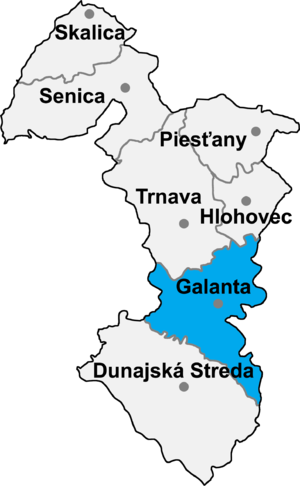
Šintava
Encyclopedia

Village
A village is a clustered human settlement or community, larger than a hamlet with the population ranging from a few hundred to a few thousand , Though often located in rural areas, the term urban village is also applied to certain urban neighbourhoods, such as the West Village in Manhattan, New...
and municipality
Municipality
A municipality is essentially an urban administrative division having corporate status and usually powers of self-government. It can also be used to mean the governing body of a municipality. A municipality is a general-purpose administrative subdivision, as opposed to a special-purpose district...
in Galanta District
Galanta District
Galanta District is adistrict inthe Trnava Region of western Slovakia.Until 1918, the district was mostly part of theHungarian countyof Pozsony , apart from a smallarea in the east, which formed part ofNyitra county....
of the Trnava Region
Trnava Region
The Trnava Region is one of the eight Slovak administrative regions.-Geography:It is located in the middlewest part of Slovakia and forms a territorial band between the Bratislava Region and the rest of Slovakia, between Austrian and Czech borders in the north and Hungarian border in the south...
of south-west Slovakia
Slovakia
The Slovak Republic is a landlocked state in Central Europe. It has a population of over five million and an area of about . Slovakia is bordered by the Czech Republic and Austria to the west, Poland to the north, Ukraine to the east and Hungary to the south...
.
History
In historical recordsHistory
History is the discovery, collection, organization, and presentation of information about past events. History can also mean the period of time after writing was invented. Scholars who write about history are called historians...
the village
Village
A village is a clustered human settlement or community, larger than a hamlet with the population ranging from a few hundred to a few thousand , Though often located in rural areas, the term urban village is also applied to certain urban neighbourhoods, such as the West Village in Manhattan, New...
was first mentioned in 1042, when King Peter, the successor of Stephen I of Hungary, having been deprived from his throne united with German emperor Henry III to gain back its country. They launched campaign against King Samuel Aba who, in 1041, had been elected king by the aristocrats who had toppled King Peter. Peter and Henry conquered Pozsony (now: Bratislava
Bratislava
Bratislava is the capital of Slovakia and, with a population of about 431,000, also the country's largest city. Bratislava is in southwestern Slovakia on both banks of the Danube River. Bordering Austria and Hungary, it is the only national capital that borders two independent countries.Bratislava...
) and the whole area of the river Vah, castles Šintava, Galgóc (now: Hlohovec), Bana and they reached up to river Hron.
Second written historical report from year 1074 comes from Vienna picture chronicle, where Šintava castle is mentioned as a place, where owerthrown King Salomon of Hungary, son of King Andrew, was succoured by Emperor Henry IV of Germany. They fought for Salomon to regain his throne occupied by King Géza
Géza I of Hungary
Géza I was King of Hungary from 1074 until his death. During King Solomon's rule he governed, as Duke, one third of the Kingdom of Hungary. Afterwards, Géza rebelled against his cousin's reign and his followers proclaimed him king...
having his residence in Nitra. The chronicle shows: "And when the emperor came to the river Vah, Solomon rode on horseback with three formations from Šintava towards Nitra". The settlement had Hungarian majority in the 17th century according to the Turkish tax census.
Geography
The municipalityMunicipality
A municipality is essentially an urban administrative division having corporate status and usually powers of self-government. It can also be used to mean the governing body of a municipality. A municipality is a general-purpose administrative subdivision, as opposed to a special-purpose district...
lies at an elevation
Elevation
The elevation of a geographic location is its height above a fixed reference point, most commonly a reference geoid, a mathematical model of the Earth's sea level as an equipotential gravitational surface ....
of 139 metres and covers an area
Area
Area is a quantity that expresses the extent of a two-dimensional surface or shape in the plane. Area can be understood as the amount of material with a given thickness that would be necessary to fashion a model of the shape, or the amount of paint necessary to cover the surface with a single coat...
of 11.565 km². It has a population
Population
A population is all the organisms that both belong to the same group or species and live in the same geographical area. The area that is used to define a sexual population is such that inter-breeding is possible between any pair within the area and more probable than cross-breeding with individuals...
of about 1719 people.
External links
- http://www.statistics.sk/mosmis/eng/run.html

